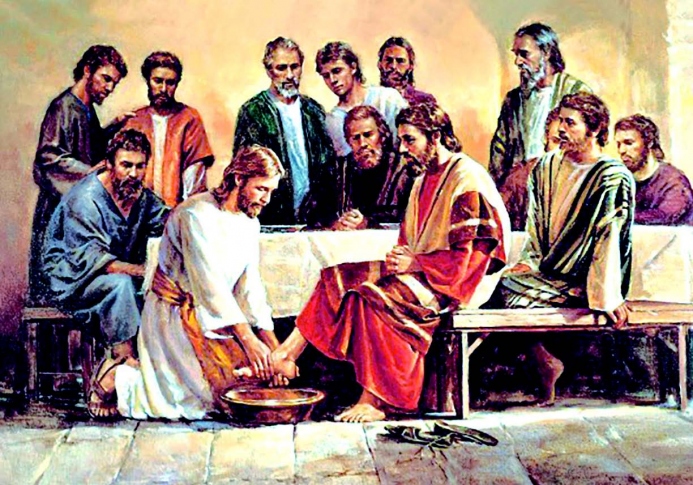
Br John Malvino Alfonso
The celebration of Easter consists of a triduum, which entails three days of preparation. It is speculated that the early Easter celebration was held as a single vigil, considered the mother of all vigils. From the 4th century onwards, due to historical considerations, it was extended to three days. It has roots in the liturgy of the Church of Jerusalem. The city that witnessed the passion, death, and resurrection of Jesus Christ sought to relive each Gospel event at the precise time and location it occurred. This triduum begins with the evening mass of the Lord’s Supper, reaches its high point in the Easter vigil, and closes with the evening prayer on Easter Sunday.
HOLY THURSDAY: Holy Thursday is a day to recall the institution of the Eucharist, the Last Supper, the institution of the Ordination, and the new commandment. It is ideal for the entire community to take part in this celebration. Prior to 1955, the Mass was celebrated in the morning, and the whole day was spent in adoration of the Sacrament. Visit to the Sacrament was a traditional devotional practice. However, from 1965, the Mass has been shifted to the evening, with adoration until midnight. Holy Thursday is also called as Maundy Thursday. The term ‘Maundy’ is derived from the Latin word ‘mandatum,’ which means commandment, referring to Jesus' commandment to love one another as he loved them. Three main events are typically highlighted on Maundy Thursday: the Institution of the Eucharist, the Institution of Priesthood, and the Commandment of Love.
The Institution of The Eucharist: This event refers to the Last Supper, where Jesus shared a final meal with his disciples before his crucifixion. During this meal, Jesus instituted the sacrament of the Eucharist, also known as Communion or the Lord's Supper. He took bread, blessed it, broke it, and gave it to his disciples, saying, “Take, eat; this is my body.” Then he took the cup, gave thanks, and gave it to them, saying, “Drink from it, all of you; for this is my blood of the covenant, which is poured out for many for the forgiveness of sins.” (Matthew 26:26-28) Christians believe that through the Eucharist, they partake in the body and blood of Christ, symbolizing his sacrifice for the forgiveness of sins and the nourishment of the soul.
The Institution Of Priesthood: Another significant aspect of Maundy Thursday is Jesus’ establishment of the priesthood. During the Last Supper, Jesus washed the feet of his disciples, demonstrating humility and servanthood. This act symbolized the importance of humility and service in Christian leadership. Furthermore, Jesus instructed his disciples to continue this practice, indicating the importance of service and leadership within the Christian community. In washing the disciples' feet, Jesus also symbolically cleansed them, preparing them for their future role in spreading his teachings and establishing the Christian church.
The Commandment Of Love: Perhaps the most emphasized aspect of Maundy Thursday is Jesus' commandment to love one another. During the Last Supper, Jesus said to his disciples, “A new command I give you: Love one another. As I have loved you, so you must love one another. By this everyone will know that you are my disciples if you love one another.” (John 13:34-35) This commandment encapsulates the essence of Christian faith, emphasizing the importance of love, compassion, and selflessness. It serves as a guiding principle for Christian conduct and relationships, reminding believers of their duty to emulate Christ's love in their interactions with others.
The Washing Of The Feet: It is yet another sign of service and self-giving that is underlined on this day. Washing of the feet was introduced into the Roman liturgy in the 12th century. In this ceremony of Washing the feet, we remember, how in this great last act of Jesus, he shows himself, to be totally at the service of his disciples. It first began in monasteries as a sign of humble service of the community members. Cloistered Carmel Monastery, Chicalim, continues this sign as the Prioress (Superior) washes the feet of the community members.
The Tridentine Missal in 1570 (Pope Pius V) had it after the Mass, whereas the present Missal has it after the homily. Washing of the feet is optional. In Goa, every Parish has this sign of washing the feet of the parishioners, mostly those serving the parishes in different ways. Hot Cross buns are given to them after washing their feet. But in some Parishes, every family is given these cross buns to share among themselves.
On Holy Thursday, after the Gloria, church bells remain silent until the Gloria of Easter. This practice dates back to the 9th century. Wooden clappers were used in place of bells. Still, these clappers are used in the Goan Churches. Similarly, musical instruments were also silenced to express the nature of the celebration, the fast of ears.
The biblical readings on this day recall the Jewish Passover, the psalm meditates on the importance of the Eucharist, the second reading on the institution of the Eucharist, and the Gospel recalls the washing of the feet and the new commandment. After the concluding prayer, no dismissal rite is to be observed.
Adoration Service Till Midnight: After the Communion, the pre-sanctified gifts are carried in a solemn procession to the side altar or to a chapel in view of Holy Communion on Good Friday. The adoration of the Sacrament began when reservation in the chapel was considered the Holy Sepulcher. Small Christian Communities or wards of the parishes in Goa are marked to conduct these adoration services. Usually from 11 pm to midnight, a holy hour is observed by all. However, the New Missal forbids solemn adoration after midnight. The stripping of the altar is done to recall the removal of Jesus’ clothes.
